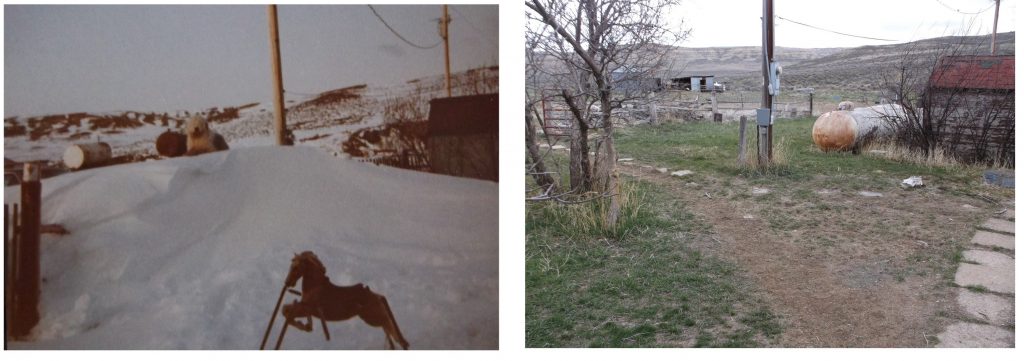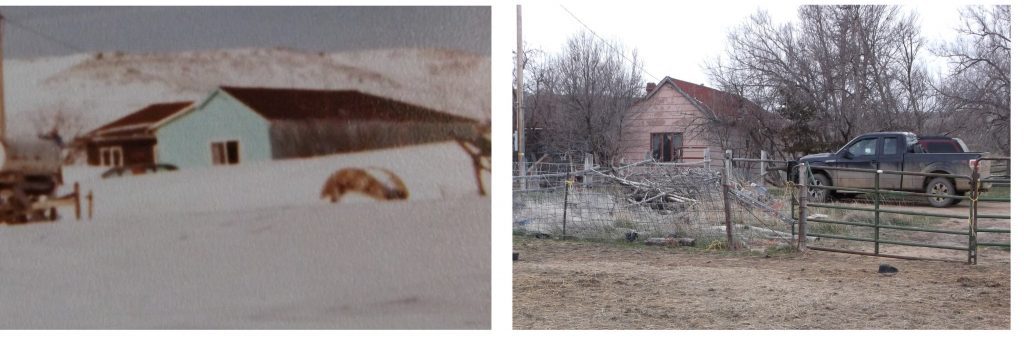News
Remembering the 1984 Spring Blizzard

Lorraine Vannoy and her Grandson, Philip Lovato walk on one of the massive drifts
While Wyoming is no stranger to savage winter snow storms, the April, 1984 Blizzard stands out in most resident’s minds as one of the worst. Following a difficult winter, where the thermometer hovered around -20 for days on end, residents hoped the end was in sight as winter moved towards spring. Yet, nature wasn’t finished. The snow and wind started on the night of April 24.
Wallace Vannoy, area rancher who, with Bernard Betz ran the U-Milliron Cattle Company near Clearmont, wrote in his journal, “April 25 – Snowed all night and still snowing now at 1:20, some wind. Linda came back from Sheridan, had to have a tow up Jim Creek Hill. No other trouble.
April 26 – Snowing and blowing continues. Drifting everywhere. Maybe be worse than ‘55. (the 1955 Blizzard) will not be able to get into pasture with pickup. (to feed cattle)
Friday, April 27 – Still blowing, drift across driveway over 7 foot, I think. Some snow with it too.
Saturday April 28 – Has quit snowing, but still blowing. Visibility has gone from 1/8 of a mile to 5 miles. Bernard working on clearing road with the Caterpillar.”

To check on the cattle losses from the storm, Vannoy hired helicopter from Big Horn Airways. His journal continues, approximately on May 1st.
“Days I’ve lost track of – the chopper came about 2, and we flew for 2 hours. Dug several cattle out of snowed in places. Saw several dead cows and calves. Have not got a good count. Only the melting of the snow will reveal the loss.
Bernard Betz ran cattle with Wallace on the ranch that Ben Vannoy, Wallace’s father and Bernard’s grandfather, established near Clearmont, Wyoming in 1917.
Betz talks of his memories of the storm. “That blizzard was one of the worst we’ve ever had in this area. I’m not sure how widespread it was. The worst, during December, the temperature was 20-below for days on end. The storm killed a lot of deer. The wind changed from the NE then switched and blew out of the south.” Many animals got buried when the snow blew over them. Betz felt that the company lost 35 or 40 head. “Mostly cows. We had quite a few bum calves that year.”
Sheep ranchers suffered the most. According to a Buffalo Bulletin article, some Sheridan and Johnson County ranchers lost between 10 and 50 percent. One Johnson County rancher lost more than 3000 head.
Sheridan County was declared a disaster and emergency area, and Johnson county was in the process. In the May 13, 1984 Billings Gazette, said the Wyoming Disater and Civil defense Agency said it had reports of “88,000 lamb and sheep deaths, and about 20,00 cattle deaths in Wyoming.
In an April 30th issue of the Casper Star Tribune, some areas of northern eastern Wyoming got up to 5 feet of snow, with winds gusting to 60 mph. Drifts in Gillette were reported to be as high as 22 feet. According to the same article, the National Weather service said that the blizzard rivaled such storms as the Jan. 1949 storm, with 30 inches of snow and winds of 66 mph., and the 1955 storm.
Ralph Foster, has run the Flying U Ranch near Clearmont since the late 1940s, tells about the impact of the storm on his sheep and his neighbors livestock.
Foster said the day before the blizzard was a nice day. Sunny and warm. Him and his nephew, Jeff Heimbaugh from Pennsylvania who was staying with them, had taken a drive through the hills. Ralph tells it in his own words.
One of his neighbors had just finished calving, and lost almost all of his livestock in the storm and had to sell his ranch the next year.
In the case of the Flying U, Foster said they had just sheared the sheep, and most had lambed out.
“The sheep drifted before the storm and fell down over cut banks, and were buried. We lost around 200 head of ewes, and even more lambs.” (Ewes tend to have twin lambs) “When the snow began to melt, we found piles of sheep.”
The Foster family survived the storm and started over, “I bought 200 head of sheep from Gene Gligorea. The sheep were from Texas, and there were a lot of lambs.” Foster added.
Linda Lovato, former Clearmont resident, now of Laramie, left Sheridan heading to Clearmont and was caught on Jim Creek Hill as the storm worsened. “I passed the snow plow, I should have stayed behind it,” Lovato said. “I had to be recused and had to be towed up the hill. I did make it to Clearmont okay.”
Eight Wyoming counties were declared disaster areas, Sheridan, Johnson, Campbell, Natrona, Weston, Crook, Converse and Niobrara.
The wildlife herds were also adversely affected. In a September 1984 Buffalo Bulletin, last minute adjustments were made the number of licenses issued. Wyoming Game Warden Rick Pallister was quoted as saying “Its going to be very difficult to hunt this year. The ranchers are reporting that they’re just not seeing deer at all this fall.”
Although outfitters had to honor the hunters they had booked for the fall of 1984, many cut back on the hunting for next few years to allow the herds to recover from the storm. In some areas the mule deer were hit hard by the storm.
Livestock and wildlife, and in Gillette one human, lost lives during the April storm of 1984. It took nearly a week after the storm ended for plows to clear the 37 miles between Sheridan and Clearmont on highway 14/16. The storm will live forever in the minds of those who lived it, as one of the worst spring storms ever to hit northeast Wyoming.


